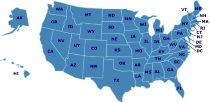Historic Sites
Learn through history by visiting interesting historic sites around the state of Ohio. Historic sites let you put a real face on the history that you've read about, making it more exciting for you and your children.
Historic Sites in Ohio
James A. Garfield National Historic Site
James A. Garfield National Historic Site preserves the property associated with the 20th President of the United States. Garfield acquired the home in 1876 to accommodate his large family. The home, named Lawnfield by reporters, was the site of the first successful front porch campaign in 1880. James A. Garfield was President from March 4, 1881 until his death on September 19, 1881. Four years after his assassination, the Memorial Library wing was added by Mrs. Garfield and her family - setting the precedence for presidential libraries.
William Howard Taft National Historic Site
The William Howard Taft National Historic Site commemorates the only man to serve as President and Chief Justice of the United States. The house that Taft was born in has been restored to its original appearance. A visit to the site includes a tour of the restored birthplace and four period rooms that reflect the family life during Taft's boyhood. The home also includes second floor exhibits highlighting Taft's life and career. The Taft Education Center, located adjacent to the Birthplace, houses an orientation video, exhibits on later generations of the Taft family, and classrooms for visiting schools. The signature exhibit of the center is an animatronic figure of the President's Son, Charlie Taft. Charlie tells stories about different family members.
Hopewell Culture National Historical Park
From about 200 BC to AD 500, the Ohio River Valley was a focal point of the prehistoric Hopewell culture. The term Hopewell describes a broad network of beliefs and practices among different Native American groups over a large portion of eastern North America. The culture is characterized by the construction of enclosures made of earthen walls, often built in geometric patterns, and mounds of various shapes. Visible remnants of Hopewell culture are concentrated in the Scioto River valley near present-day Chillicothe, Ohio. The most striking Hopewell sites contain earthworks in the form of squares, circles, and other geometric shapes. Many of these sites were built to a monumental scale, with earthen walls up to 12 feet high outlining geometric figures more than 1000 feet across. Conical and loaf-shaped earthen mounds up to 30 feet high are often found in association with the geometric earthworks. The park contains nationally significant archeological resources including large earthwork and mound complexes that provide an insight into the social, ceremonial, political, and economic life of the Hopewell people. The park visitor center features museum exhibits, an orientation film, book sales area, and self-guided and guided tours.
Featured Resources
As an Amazon Associate, we earn from qualifying purchases. We get commissions for purchases made through links on this site.
Black Books Galore's Guide to Great African American Children's Books
"This is a great resource that fills a tremendous need. It should be on parents' shelves at home as well as in every school." —Alvin F. Poussaint, M.D. Harvard Medical School These are exciting times for African American children's literature. Never before have there been so many titles available. Now the three mothers who founded Black Books Galore! —the nation's leading organizer of festivals of African American children's books —share their expert advice on how to find a...
The Well-Ordered Home: Organizing Techniques for Inviting Serenity into Your Life
Organizing the home is one of those desirable and beneficial activities that remain elusive for many. This practical guide explains the many benefits - physical, emotional, and spiritual - of an organized home and shows how to attain them. Breaking down the process into 50 steps, the author uses her own experiences as a psychologist and professional home organizer to help readers clear away not only the physical clutter but the psychological blocks that encourage it and hinder organization. She ...
Dr. Montessori's Own Handbook
A short, illustrated guide to the use of Montessori classroom materials. Describes how to set up a "children's house" - an environment for learning where children can be their own masters.
Homeschooling: The Teen Years : Your Complete Guide to Successfully Homeschooling the 13- to 18- Year-Old (Prima Home Learning Library)
The teen years are when many homeschooling parents start to question or abandon their efforts. It's a precarious time, with challenging academics, pressing social issues, and the prospect of college looming. Parents can now breathe easy: this guide calms the teen-time jitters and even offers hope to those just turning to homeschooling now that their child is about to enter high school. With brief "how we did it" testimonies from other parents sprinkled throughout the book, author Cafi Cohen offe...
For the Learners' Sake: Brain-Based Instruction for the 21st Century
This proposal for a platform of education reform needed to prepare students for a 21st-century workplace and society draws on information and ideas from two current areas in neuroscience: brain research (physiology and applications to learning) and systems thinking (mental models). Analyzing the history of education methodology over the past two centuries, this book shows how the 19th-century factory model prevalent in schools today fail to produce the kinds of flexible thinkers and problem solv...





